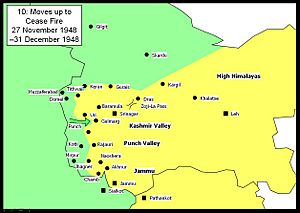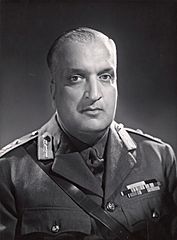Separatist movements of India facts for kids
Secession in India is when a group wants one or more states to leave the Republic of India and become a separate country. Some groups want to create a new state or union territory within India, not leave it completely.
There are many movements in India that want to separate. Some have thousands of members, while others have less support from local people. Many people in these areas still vote in elections, showing they want to be part of India's democratic system.
The Khalistan movement in Punjab was very active in the 1980s and 1990s but was stopped by the Indian Army. However, some small groups still exist.
In Northeast India, several armed groups operate. This region is connected to the rest of India by a narrow piece of land called the Siliguri Corridor. The Northeast includes the states of Assam, Meghalaya, Tripura, Arunachal Pradesh, Mizoram, Manipur, and Nagaland. There have been tensions between these groups and the government. However, violence in the region has gone down a lot in recent years.
In Jammu and Kashmir, an insurgency began in 1989. Some groups want to be independent, while others want to join Pakistan. The conflict is linked to a long history and a debate over the region's self-rule. In 2019, the Indian government changed the special status of Jammu and Kashmir. This led to increased security and a long lockdown to prevent unrest.
To deal with these movements, India has special laws like the Armed Forces Special Powers Acts (AFSPA). This law gives the army special powers in certain areas. Human rights groups have criticized the law, but the government says it is needed to keep order.
Contents
Causes of Separatist Movements
The reasons for these movements are different in each region, but there are some common problems.
- A lack of development and jobs can make people feel left behind.
- Disagreements over land and forests are also a major cause.
- Sometimes, differences in ethnicity, language, or religion are used to divide people.
- Actions taken by the government to stop the movements can sometimes make the situation worse.
For example, in some tribal areas, people feel that the government has not done enough to help them. Insurgent groups sometimes step in and provide services like schools or medical help. This can make them popular with local people, especially young people who can't find jobs.
In Kashmir, the conflict grew after a state election in 1987 that many people believed was unfair. This event caused many to lose faith in the democratic process and support groups that wanted to separate from India.
Naxalite-Maoist Insurgency
The Naxalite–Maoist insurgency is a conflict between Maoist groups, called Naxalites, and the Indian government. It began in 1967 in a village called Naxalbari in West Bengal. Former Prime Minister Manmohan Singh once called it India's "biggest threat to internal security."
History of the Naxalite Movement
The movement was inspired by the ideas of Mao Zedong, a Chinese communist leader. It started when poor farmers and tribal people began to fight against landlords to take back their land. The movement quickly spread to other parts of India.
In 1969, the Communist Party of India (Marxist–Leninist) (CPI-ML) was formed. However, the party soon split into many smaller groups. By the 1970s, the government had cracked down on the movement, and many of its leaders were arrested.
In the 1980s, the movement became strong again, especially in the state of Andhra Pradesh. Naxalite groups set up strongholds in forest areas. The government used special police forces, like the Greyhounds, to fight them.
The Movement Today
In 2004, several Naxalite groups joined together to form the Communist Party of India (Maoist). This group is active in the forest areas of states like Chhattisgarh, Jharkhand, and Odisha. This area is sometimes called the Red corridor.
The Naxalites say they are fighting for the rights of the poor and tribal communities, who they believe have been ignored by the government. They get money by taxing mining companies in the areas they control. The government has continued to fight the Naxalites with police and military operations.
Jammu and Kashmir
The conflict in Jammu and Kashmir is one of India's longest and most difficult challenges.
How the Conflict Began
In 1947, when India and Pakistan became independent from Britain, the princely state of Jammu and Kashmir had to decide which country to join. The ruler, Maharaja Hari Singh, was Hindu, but most of the people were Muslim. He could not decide what to do.
In October 1947, fighters from Pakistan invaded Kashmir. The Maharaja asked India for help. India agreed, but only if he signed an Instrument of Accession, making Kashmir part of India. He signed it, and Indian soldiers were sent to fight the invaders.
This led to the Indo-Pakistani War of 1947. The war ended in 1949 with a ceasefire line dividing Kashmir between India and Pakistan. The United Nations suggested that the people of Kashmir should vote to decide their future, but this vote never happened.

The Rise of Insurgency
For many years, the region was mostly peaceful. But in the 1980s, things started to change. A state election in 1987 was believed to be rigged, which made many young Kashmiris angry. They felt that they could not express their views peacefully.
Many of these young men joined groups like the Jammu and Kashmir Liberation Front (JKLF), which wanted an independent Kashmir. In 1989, the conflict became more intense. Pakistan began to support militant groups in the region. This led to a violent period, and many Kashmiri Hindus, also known as Pandits, had to flee the Kashmir Valley.
Recent Events
On August 5, 2019, the Indian government removed the special status of Jammu and Kashmir, which was granted under Article 370 of the constitution. The government also split the state into two union territories: Jammu and Kashmir, and Ladakh.
To prevent protests, the government put the region under a strict lockdown, cut off phone and internet lines, and arrested many political leaders. The government said these actions were needed to stop terrorism and bring development to the region.
Punjab
The Khalistan movement is a movement that wants to create a separate country for Sikhs called Khalistan. This proposed country would be in the Punjab region.
History of the Khalistan Movement
The idea for a separate Sikh state started after the end of the British Empire in India. In the 1970s and 1980s, the movement grew stronger, with support from Sikhs living in other countries.
In June 1984, the Indian government launched Operation Blue Star, a military operation to remove Sikh militants from the Harmandir Sahib (Golden Temple) in Amritsar. The leader of the militants was Jarnail Singh Bhindranwale. Many Sikhs around the world were angry about the attack on their holiest shrine.
Five months later, Prime Minister Indira Gandhi was killed by her two Sikh bodyguards as an act of revenge. This led to terrible riots in which thousands of Sikhs were killed, especially in Delhi.
By the 1990s, the movement had weakened due to police action and a lack of support from the Sikh population.
Northeast India
Northeast India has many different ethnic groups and has seen several separatist movements.
Assam
In Assam, the main conflict has been between the local Assamese people and migrants from other places, especially Bangladesh.
- The United Liberation Front of Asom (ULFA) was formed in 1979. It wants to create a separate country for the Assamese people. The Indian government has banned ULFA and considers it a terrorist group.
- The Kamtapur Liberation Organisation (KLO) wants to create a separate Kamtapur state for the Koch Rajbongshi people.
- Groups like the National Democratic Front of Bodoland (NDFB) fought for a separate Bodoland for the Bodo people. In 2020, they signed a peace deal with the government.
Nagaland
In the 1950s, the Naga National Council led a violent fight for a separate country for the Naga people. The fighting decreased after the state of Nagaland was created in 1963. However, some groups, like the National Socialist Council of Nagaland, still want an independent Nagalim.
Mizoram
The Mizo people felt they were not treated fairly by the Assam government. This led to the formation of the Mizo National Front (MNF) in 1961, which wanted a separate country for the Mizos.
In 1966, the MNF declared independence and attacked government buildings. The Indian government responded with airstrikes, which was the only time India has used its air force against its own citizens.
In 1986, the MNF signed the Mizo accord with the government. They gave up their demand for a separate country, and Mizoram became a state of India.
Manipur
The Kingdom of Manipur joined India in 1949. Some people were unhappy with the merger and formed groups to fight for an independent Manipur.
The conflict in Manipur is very complex, with many different ethnic groups and militant organizations. The rise of Naga groups in the state also led to clashes with the local Kuki and other tribes, who formed their own groups to protect themselves.
In May 2023, violence broke out between the Meitei and Kuki communities. This has led to a new wave of insurgency in the state.
See also
- Territorial disputes of India
- Proposed states and union territories of India
- Autonomous administrative divisions of India


